Hey everyone,
Hope you all enjoy our blog on Death Eaters in the Harry Potter series! We will explain more about it tomorrow, but for now, have fun looking around.
https://deatheaterstudies.wordpress.com/
-Hannah, Jen, and Tina
Hey everyone,
Hope you all enjoy our blog on Death Eaters in the Harry Potter series! We will explain more about it tomorrow, but for now, have fun looking around.
https://deatheaterstudies.wordpress.com/
-Hannah, Jen, and Tina
It’s difficult for me to narrow down how much I’ve learned this semester about Digital Humanities. I guess I’ll choose my good examples from my favorite topics: archives, wordclouds, and topic modeling:
With archives like the Old Bailey, data can be easily accessible online. So so so much data, including books, photos of paintings, sound bits, video, and et cetera. It’s not just digitally scanned documents anymore. You no longer have to travel to some dark basement or well established college in England to see the original paper documents– they are scanned for you, ready to be read. Although physicality is still important, digital archives offer ways to the general public to access once hidden and/or difficult to study materials. Problems concerning this access and what gets put up online are certainly an issue, but digital archives allow scholars and non scholars alike to access things… Which is pretty neat.

The Old Bailey Proceeding site is easy to navigate, offering plenty of instructive videos on the search functions. Huge plus, especially given how much info there is. It also provides illustrations pertaining to the Old Bailey’s history, in paintings or photographic form. The graphic design choices remain uniform and pertinent to the topics at hand. If you are interested, the site allows you to look at original copies of some proceedings. Also, all the data is cited, a number one rule. Continue reading
A good DH project must presents some features, as we have discussed through this course. I have selected five from these important qualities:
1) Built in collaboration
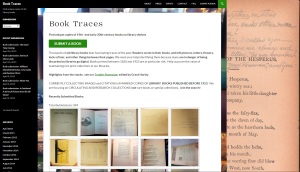
A good DH project is “open-ended”, which means, a lot of scholars or regular people can contribute adding material. Book Traces is a good example. You can easily submit a 19th century book, which contains something on its “marginalia” or objects inside. It is interesting because it is a collective effort to preserve endangered books, which can be discarded by libraries or disintegrated by the time.
This feature makes the project more effective, because its resources can grow in number and quality faster, as a lot of people are helping.
Collaboration also allows scholars to publish their work before finishing it, so they can get feedback from the audience, from other scholars and, then, improve their work. These “work in progress” was really difficult when the projects were paper-based.
2) Be Scholarly developed and oriented to scholars
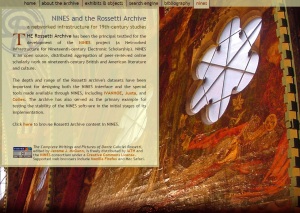
Being a scholarly project means that it has been built based on reliable sources and that the project cites those sources properly. Projects which are developed by Universities or Research Institutes are scholarly. However, everyone can build a scholarly project, if he/she is concerned where he/she gets the data and how he/she cites where it came from.
The Rossetti Archive is a good example of a scholarly project. It has been developed as a basis for the project NINES (Network Infrastructure for Nineteenth-century Electronic Scholarship), which demonstrates that it is built towards scholarly purposes. As it is stated on the website, “the Archive provides students and scholars with access to all of DGR’s pictorial and textual works and to a large contextual corpus of materials(…)” – (The Rossetti Archive, section Home).
3) Integration
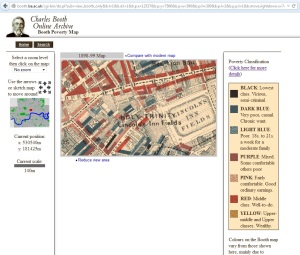 Good DH projects gather a number of objects, maps or even scholarly texts into a single digital interface. This characteristic makes them useful as a scholar or a student can find plenty of information in the same place. Moreover, the digital platforms make possible to conjugate several levels of information onto the same visualization, which would be confusing using printed materials. This is the case of Locating London’s Past, which put together 24 printed maps. Charles Booth Archive is another example. Different colors represent each kind of information, such as crime’s incidence and population through region.
Good DH projects gather a number of objects, maps or even scholarly texts into a single digital interface. This characteristic makes them useful as a scholar or a student can find plenty of information in the same place. Moreover, the digital platforms make possible to conjugate several levels of information onto the same visualization, which would be confusing using printed materials. This is the case of Locating London’s Past, which put together 24 printed maps. Charles Booth Archive is another example. Different colors represent each kind of information, such as crime’s incidence and population through region.
4) Be user-friendly
A good DH project is concerned about how is it easy to a user to figure out by him/herself how the platform works. Being user-friendly involves displaying the information on the screen in an easy way to read and find the data the user is looking for. Locating London’s Past really fulfills this expectation. Besides using design resources to display the information in a clear and readable way, they offer tutorial videos. Besides that, all the tabs follows a coherent organization. 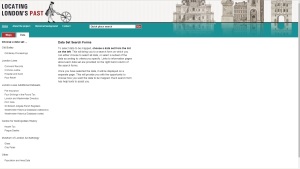 At the top of the page, the user find the two ways of researching – directly onto the map or looking for specific data. Since he decides for data, all the data sets will show up on the left side and the user can pick one up and fill the blanks to find the information he wants.
At the top of the page, the user find the two ways of researching – directly onto the map or looking for specific data. Since he decides for data, all the data sets will show up on the left side and the user can pick one up and fill the blanks to find the information he wants.
Thus, part of being user-friendly is presenting the next DH project’s quality – Design.
5) Design
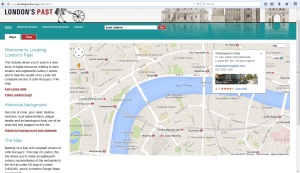 As the article Radiant Textuality explains, “computerization not only vastly increases the amount of accessible information, it enables much greater flexibility in the ways information can be shaped, scaled, and negotiated” (p. 385). Then, a good DH project takes advantage of the design resources to be good-looking, which makes it attractive to the user as well as user-friendly. Using design properly means doing smart choices of colors, different font types and font sizes to organize and categorize different kinds and levels of information. As the image on the right shows, Locating London’s Past is really successful in using design skills. We can identify the use of the variety of font sizes, and a use of colors that is related to the English flag.
As the article Radiant Textuality explains, “computerization not only vastly increases the amount of accessible information, it enables much greater flexibility in the ways information can be shaped, scaled, and negotiated” (p. 385). Then, a good DH project takes advantage of the design resources to be good-looking, which makes it attractive to the user as well as user-friendly. Using design properly means doing smart choices of colors, different font types and font sizes to organize and categorize different kinds and levels of information. As the image on the right shows, Locating London’s Past is really successful in using design skills. We can identify the use of the variety of font sizes, and a use of colors that is related to the English flag.
On the other hand, the archive Sherlockian.net has a lot to improve concerning to design. The use of colors doesn’t seem to have a purpose. The yellow background and the small font type, as well as the organization of tabs and objects is not very readable and doesn’t attract the user. The links are presented in the regular blue color, which also badly affects the whole appearance of the website.
How DH lets scholars ask new questions?
Through DH, scholarly work can be preserved and self-integrated much better than on paper-based instruments. As Jerome McGann affirms in Radiant Textuality, now it is possible to “integrate the resources of all libraries, museums, and archives and make those resources available to all persons no matter where they reside physically” (p. 381). He adds that “electronic publishing permits scholars to present their work in far greater depth and diversity. Essays can present all their documentary evidence as part of their argument (in notes and appendices, or in electronic links to the original documents). They can also exploit fully the use of illustrations and images, including video film clips, as well as audio clips” (p. 384).
Therefore, DH brings up new issues, that couldn’t be seen without the new technologies such as maps, graphics and visualizations. Scholars and students start to search and identify patterns between data, which was really difficult to do with paper based documents. We didn’t have everything together, online, available to access from any place in the world. Now we can compare information at the same screen, and ask questions about what they signify, which trends we can distinguish. Technologies such as N-grams enable us to exercise these skills of discerning trends and patterns. DH projects can function as a beginning of a research, as we discover some data and start looking for the meaning of it.
Furthermore, digital platforms are available to a broader audience and enable critics to dialogue, as well (p. 387). Thus, scholars can discuss and bring different points of view about some data, which means that DH permits scholars to ask new questions.
For this assignment, I decided to focus on Fenchurch Street, a location that was mentioned in the Sherlock Holmes story A Case Of Identity. In the story, Fenchurch Street is the location of Miss Sutherland’s step-father’s place of business. Located just around the block from here is Miss Sutherland’s fiancee’s home on Leadenhall Street, which (SPOILER ALERT) turns out to be Miss Sutherland’s step-father. You can see a picture of Fenchurch Street on a map I got from Victorian Google Maps below:
When I looked at the Charles Booth Online Archive, I found out that during the 19th century Fenchurch Street was a very poor area, as you can see on the map and color guide below. The black and blues show that people of the lowest classes lived in this area. This relates back to the Holmes story because Mr. Windibank, Miss Sutherland’s step-father, tried to pose as another man to make Miss Sutherland fall in love with him so he could eventually marry her and take all her money. Mr. Windibank’s place of business was also located just around the block from Fenchurch Street on Leadenhall Street. This area was a good location for Arthur Conan Doyle to put both of Mr. Windibank’s identities in because it shows that he has very little money. If he lived and worked in a different area it wouldn’t make as much sense to the story.
On the Old Bailey Archive, I did a search on my location and found a list of the crimes committed throughout the 19th century. Most of these crimes listed were for all things theft related, like grand larceny, shoplifting, pickpocketing, and even a couple of theft related murders. When I looked at the Locating London website, I found similar results. Then I decided to look at the British History Online website. When I searched my location on there, I found many texts involving businesses and factories, where I learned that this area held many businesses and industries and probably had many jobs that people of the working class had. I’m not saying that poor people were more likely to be criminals, but in order to survive and support their families people of the lower classes needed to do what they could, and theft was probably a last resort option for them to get necessities.
My Fusion Tables Link and Google Sheets Link

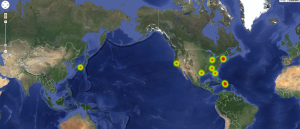
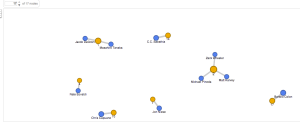
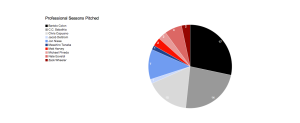
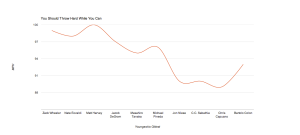
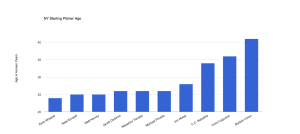
If you made it this far thinking about baseball and numbers, Congratulations! Let’s elect the pitcher with the “Best Hair”:


I decided to examine the area of Tottenham Court Road which was mentioned in Sherlock Holmes: The Adventure of the Blue Carbuncle. In this adventure, Holmes’ acquaintance Peterson witnesses a group of men attacking a man named James Ryder, all this unfolds on the notorious Tottenham Court Road of London.
I found that the most useful source for examining this area was the British History Online. Searching my subject, i was given many scholarly sources, of which I picked an excerpt from an encyclopedia on metropolitan history from 1878. The piece was part of the Northern Tributaries section, and I discovered that Tottenham was once one of the most fashionable districts in all of London. However at the time of this piece’s publication there was no longer royalty in Tottenham, but rather it was bound by poverty and the lower class. There were still handsome squares and private mansions but it explained that the “poverty is almost hopeless.”
I furthered this perception of Tottenham through Old Bailey Online. This lower class area was home to a lot of crime during the Victorian era. In the scope of this archive, there were 3666 mentions of this area in court proceedings, so basically two percent of all of the recorded crimes in London took place in, or have some connection with Tottenham Court road.
The least useful source for this project was Charles Booth Online Archive. This platform was not user friendly to the slightest extent, so I was not able to find any knowledge about Tottenham Court road.
Works Cited:
Old Bailey Online. 2003. Accessed November 9, 2014. www.oldbaileyonline.org/index.jsp
Tottenham Court Road‘, Old and New London: Volume 4 (1878), pp. 467-480. URL: http://www.british-history.ac.uk/report.aspx?compid=45208&strquery=Tottenham Court Road Date accessed: 10 November 2014.